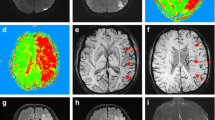Abstract
Purpose
Prior studies have used the fluid-attenuated inversion recovery sequence signal intensity ratio (FLAIR-SIR) to predict those with an incomplete infarct that may safely receive acute thrombolytics. Clinical early neurologic deterioration (END) of small subcortical infarcts (SSIs) is suspected to occur due to delayed infarct completion. We aimed to understand if a lower FLAIR-SIR, suggestive of an incomplete infarct, would have a higher likelihood of SSI-related END.
Methods
A cross-sectional retrospective study was performed of those with an acute SSI (anterior or posterior circulation) without significant parent vessel steno-occlusive disease. END was defined as a new or worsened disabling neurologic deficit during the index hospitalization. Standard-of-care brain MRIs were reviewed from the hospitalization, and a FLAIR-SIR cutoff of ≤ 1.15 was used based on prior studies. Adjusted logistic regression models were used for analysis.
Results
We identified 252 patients meeting inclusion criteria: median (IQR) age 68 (12) years, 38.5% (97/252) female, and 11% (28/252) with END. Tobacco use was more common in those without END (32%) compared with END (55%, p = 0.03). In adjusted analyses, a FLAIR-SIR cutoff of ≤ 1.15 yielded an odds ratio of 2.8 (95% CI 1.23–6.13, p = 0.012) of early neurological deterioration.
Conclusion
Those with a FLAIR-SIR ≤ 1.15 are nearly threefold more likely to develop SSI-related END.


Similar content being viewed by others
Data availability
Anonymized data not published within this article will be made available by request from a qualified investigator.
References
Sacco S, Marini C, Totaro R et al (2006) A population-based study of the incidence and prognosis of lacunar stroke. Neurology 66:1335–1338
Woo D, Gebel J, Miller R et al (1999) Incidence rates of first-ever ischemic stroke subtypes among blacks: a population-based study. Stroke 30:2517–2522
Regenhardt RW, Das AS, Ohtomo R et al (2019) Pathophysiology of lacunar stroke: history’s mysteries and modern interpretations. J Stroke Cerebrovasc Dis 28:2079–2097
Wardlaw JM, Smith EE, Biessels GJ et al (2013) Neuroimaging standards for research into small vessel disease and its contribution to ageing and neurodegeneration. Lancet Neurol 12:822–838
Caplan LR (2015) Lacunar infarction and small vessel disease: pathology and pathophysiology. J Stroke 17:2–6
Steinke W, Ley SC (2002) Lacunar stroke is the major cause of progressive motor deficits. Stroke 33:1510–1516
Del Bene A, Palumbo V, Lamassa M et al (2012) Progressive lacunar stroke: review of mechanisms, prognostic features, and putative treatments. Int J Stroke 7:321–329
Berberich A, Schneider C, Reiff T et al (2019) Dual antiplatelet therapy improves functional outcome in patients with progressive lacunar strokes. Stroke 50:1007–1009
Yaghi S, Raz E, Yang D et al (2021) Lacunar stroke: mechanisms and therapeutic implications. J Neurol Neurosurg Psychiatry 92:823–830
Ma H, Campbell BCV, Parsons MW et al (2019) Thrombolysis guided by perfusion imaging up to 9 hours after onset of stroke. N Engl J Med 380:1795–1803
Thomalla G, Simonsen CZ, Boutitie F et al (2018) MRI-guided thrombolysis for stroke with unknown time of onset. N Engl J Med 379:611–622
Schwamm LH, Wu O, Song SS et al (2018) Intravenous thrombolysis in unwitnessed stroke onset: MR WITNESS trial results. Ann Neurol 83:980–993
Nakamura K, Saku Y, Ibayashi S, Fujishima M (1999) Progressive motor deficits in lacunar infarction. Neurology 52:29–33
Terai S, Hori T, Miake S et al (2000) Mechanism in progressive lacunar infarction: a case report with magnetic resonance imaging. Arch Neurol 57:255–258
Giraud M, Cho T-H, Nighoghossian N et al (2015) Early blood brain barrier changes in acute ischemic stroke: a sequential MRI study. J Neuroimaging 25:959–963
Neumann-Haefelin T, Kastrup A, de Crespigny A et al (2000) Serial MRI after transient focal cerebral ischemia in rats: dynamics of tissue injury, blood-brain barrier damage, and edema formation. Stroke 31:1965–1972 discussion 1972-3
Bezerra DC, Sharrett AR, Matsushita K et al (2012) Risk factors for lacune subtypes in the Atherosclerosis Risk in Communities (ARIC) Study. Neurology 78:102–108
Ejiri K, Miyoshi T, Kohno K et al (2019) Tobacco smoking protective effect via remote ischemic preconditioning on myocardial damage after elective percutaneous coronary intervention: subanalysis of a randomized controlled trial. Int J Cardiol Heart Vasc 22:55–60
Mi T, Yu F, Ji X et al (2016) The interventional effect of remote ischemic preconditioning on cerebral small vessel disease: a pilot randomized clinical trial. Eur Neurol 76:28–34
Weng W-C, Huang W-Y, Chien Y-Y et al (2011) The impact of smoking on the severity of acute ischemic stroke. J Neurol Sci 308:94–97
Author information
Authors and Affiliations
Corresponding author
Ethics declarations
Ethics approval
The study was provided a waiver of consent by the Lifespan Institutional Review Board.
Informed consent
Not applicable.
Competing interests
The authors declare no competing interests.
Additional information
Publisher’s Note
Springer Nature remains neutral with regard to jurisdictional claims in published maps and institutional affiliations.
Rights and permissions
Springer Nature or its licensor (e.g. a society or other partner) holds exclusive rights to this article under a publishing agreement with the author(s) or other rightsholder(s); author self-archiving of the accepted manuscript version of this article is solely governed by the terms of such publishing agreement and applicable law.
About this article
Cite this article
Goldstein, E.D., Fayad, F.H., Shah, A. et al. FLAIR signal intensity ratio predicts small subcortical infarct early neurologic deterioration: a cross-sectional study. Neuroradiology 66, 343–347 (2024). https://doi.org/10.1007/s00234-024-03295-1
Received:
Accepted:
Published:
Issue Date:
DOI: https://doi.org/10.1007/s00234-024-03295-1




